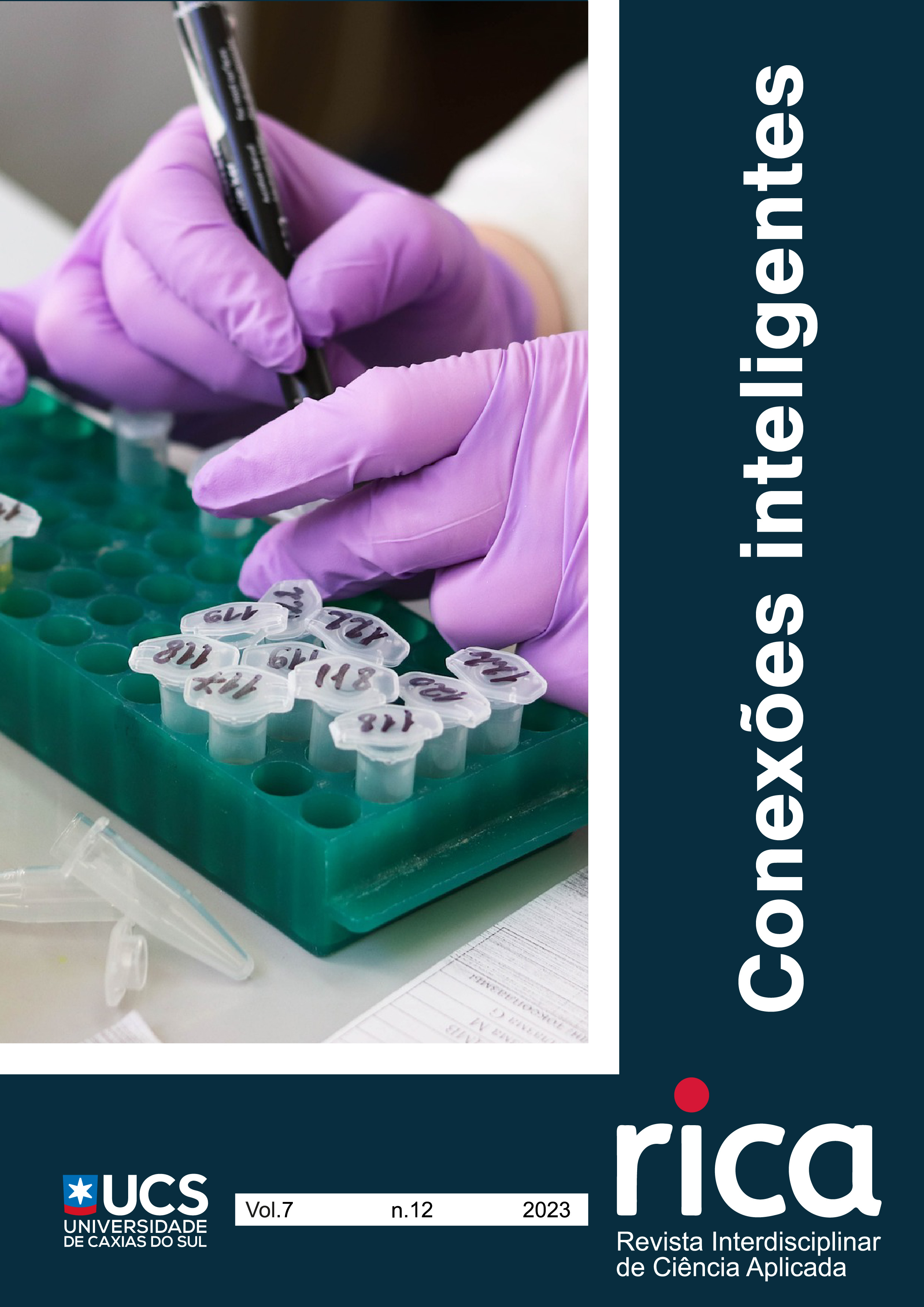Evaluation of the effect of the application of two types of potassium fertilizers on the production and quality of ungrafted Isabel’ grapes
DOI:
https://doi.org/10.18226/25253824.v7.n12.07Keywords:
fertilization, macronutrients, potassium, viticulture, Vitis labruscaAbstract
Potassium is a macronutrient responsible for regulating plants' metabolic processes and water balance. In grapevines, this nutrient strongly influences the production and quality parameters of the berries, consequently affecting the quality of the juices and wines produced. Potassium can be supplied differently, impacting vineyard productivity and grape properties. The present study aimed to evaluate the effect of applying two different fertilizers on the production and quality of ungrafted Isabel vines. The experiment was carried out in the 2016/2017 cycle in the Serra Gaúcha region. Three treatments were tested: control without fertilization (T1), addition of 80 kg∙ha-1 of K2O in the form of KCl, and addition of 80 kg∙ha-1 of K2O as the compound fertilizer form 04-18-08 (N-P-K). Yield per plant, potassium content in leaf petioles, soluble solids, titratable acidity, SS/TA ratio, must pH, and total phenolic compounds and anthocyanins content were determined. The results showed that fertilization did not influence the yield per plant nor the soluble solids content, regardless of the fertilizer used. The application of KCl caused a reduction in the titratable acidity, with a consequent increase in the SS/TA ratio. On the other hand, applying the 04-18-08 fertilizer promoted a growth in the total anthocyanin content and pH without affecting the titratable acidity. According to the results, the studied fertilizers can be used in the vine culture without damage to the productivity of the plants or the quality of the berries. Considering the use of these fruits as a feedstock for wines and juices, the 04-18-08 fertilizer would be an interesting option aiming to increase the contents of bioactive compounds, such as anthocyanins.
References
Instituto Brasileiro de Geografia e Estatística (IBGE). (2022) Produção Agropecuária: Produção de Uva – RS. Recovered from https://www.ibge.gov.br/explica/produção-agropecuaria/uvs/rs
Instituto Brasileiro de Geografia e Estatística (IBGE). ( 2022). Produção Agrícola Municipal (PAM) – Uva. Recovered from https://www.ibge.gov.br/estatisticas/economicas/agricultura-e-pecuaria/9117-producao-agricola-municipal-culturas-temporarias-e-permanentes.html?=&t=resultados
Dalbó, M. A., Bettoni, J. C., Gardin, J. P. P., Basso, C. (2015). Produtividade e qualidade de uvas da cv. Isabel (Vitis labrusca L.) submetidas à adubação potássica. Revista Brasileira de Fruicultura, 37 (3), 789-796.
Ciotta, M. N., Ceretta, C. A., Krug, A. V., Brunetto, G., Nava, G. (2021). Grape (Vitis vinifera L.) production and soil potassium forms in vineyard subjected to potassium fertilization. Revista Brasileira de Fruticultura, 43 (1), e-682.
Fugalli, M., Silvestre, W. P., & Pauletti, G. F. (2022). Avaliação da adubação potássica com adição de substâncias húmicas em videiras Isabel na Serra Gaúcha. Revista Brasileira de Viticultura e Enologia, 14, 22-37.
Conde, C., Silva, P., Fontes, N., Dias, A. C. P., Tavares, R. M., Sousa, M. J., Agasse, A., Delrot, S., Gerós, H. (2007). Biochemical changes throughout grape berry development and fruit and wine quality. Food, 1 (1), 1-22.
Villette, J., Cuéllar, T., Verdeil, J. L., Delrot, S., Gaillard, I. (2020). Grapevine potassium nutrition and fruit quality in the context of climate change. Frontiers in Plant Science, 26, 123.
Mpelasoka, B. S., Schachtman, D. P., Treeby, M. T., Thomas, M. R. (2003). A review o potassium nutrition in grapevines with special emphasis on berry accumulation. Australian Journal of Grape and Wine Research, 9, 154-168.
Delgado, R., González, M. R., Martín, P. (2006). Interaction effects of nitrogen and potassium fertilization on anthocyanin composition and chromatic features of Tempranillo grapes. International Journal of Vine and Wine Science, 40 (3), 141-150.
Fekry, W. M. E., Aboel-Anin, M. A. (2020). Effect of potassium fertilizers sources on the production, quality and chemical composition of early sweet grapes cv. under salinity stress. Asian Journal of Plant Sciences, 19 (4), 508-514.
Grant, S. (2006). Fertilizer efficiency for winegrape vineyards. Practical Winery & Vineyard. Recovered from http: lodigrowers.com/download/soil-nutrition/Grant_FertilizerEfficiency_2006.pdf
Kafkafi, U., Xu, G., Imas, P., Magen, H., Tarchitzky, J., Johnston, A. E. (2002). Potassium and chloride in crops and soils: the role of potassium chloride fertilizer in crop nutrition. International Potash Institute, Bern.
Lester, G. E., Jifon, J. L., Makus, D. J. (2010). Impact of potassium nutrition on postharvest fruit quality: Melon (Cucumis melo L.) case study. Plant and Soil, 335, 117-131.
Ren, L., Xu, G., Kirkby, E. A. (2015). The value of KCl as a fertilizer with particular reference to chloride: a mini review. International Fertilizer Correspondent, 40, 3-10.
Pereira, D. G. C., Santana, I. A., Megda, M. M., Megda, M. X. V. (2019). Potassium chloride: impacts on soil microbial activity and nitrogen mineralization. Ciência Rural, 49 (5), e20180556.
Wu, L., Li, P., Jia, H., Phillip, F. O., Bao, X., Zhao, F., Zhao, B., Feng, J., Yu, K. (2021). The effect of foliar application of K2SO4 and KH2PO4 on skin color of the ‘Kyoho’ grape. Agronomy, 11 (11), 2361.
Havlin, J. L., Austin, R., Hardy, D., Howard, A., Heitman, J. L. (2022). Nutrient management effects on wine grape tissue nutrient content. Foods, 11 (2), 158.
Pushpavathi, Y., Satisha, J., Shivashankara, K. S., Satisha, G. C., Sriram, S., Reddy, M. L. (2020). Potassium fertilization in relation to downy mildew disease incidence in grape leaves. Vitis, 59, 71-76.
Belal, B. E. A., El-Kenawy, M. A., Thoraua S. A., El-Wafa, A. B. O. (2017). Partial replacement of mineral potassium fertilizer for Thompson Seedless grapevines by using different sources of organic and natural fertilizers. Journal of Plant Production, 8 (1), 19-25.
Mostafa, M. F. M., El-Boray, M. S., El-Baz, E. L. T., Omar, A. S. M. (2017). Effect of fulvic acid and some nutrient elements on King Ruby grapevines growth, yield and chemical properties of the berries. Journal of Plant Production, 8 (2), 321-328.
Eichorn, K. W., Lorenz, D. H. (1977). Phänologische Entwicklungsstadien der Rebe. Nachrichtenb. Deutsch Pflanzenschuntzd (Braunschweig), 29, 119-120.
Conselho de Química e Fertilidade do Solo (CQFS). (2016). Manual e Calagem e Adubação para os Estados do Rio Grande do Sul e Santa Catarina. Santa Maria: Pallotti.
Malavolta, E., Vitti, G. C., Oliveira, S. A. (1997). Avaliação do estado nutricional das plantas: princípios e aplicações. 2nd ed. Piracicaba: Potafos.
Instituto Adolfo Lutz (IAL). (2008). Métodos físico-químicos para análise de alimentos. São Paulo: Instituto Adolfo Lutz.
Pereira, G. A., Arruda, H. S., Pastore, G. M. (2018). Modification and validation of the Folin-Coicalteu assay for faster and safer analysis of total phenolics content in food samples. Brazilian Journal of Food Research, 9 (1), 125-140.
Lee, J., Durst, R. W., Wrolstad, R. E. (2005). Determination of total monomeric anthocyanin pigment content of fruit juices, beverages, natural colorants, and wines by the pH differential method: collaborative study. Journal of AOAC International, 88 (5), 1269-1279.
Assis, A. M., Yamamoto, L. Y., Souza, F. S., Borges, R. S., Roberto, S. R. (2011). Evolução da maturação e características físico-químicas e produtivas das videiras ‘BRS Carmem’ e ‘Isabel’. Revista Brasileira de Fruticultura, 33, (vol. esp.), 493-498.
Rombaldi, C. V., Bergamasqui, M., Lucchetta, L., Zanuzo, M., Silva, J. A. (2004). Produtividade e qualidade de uva, cv. Isabel, em dois sistemas de produção. Revista Brasileira de Fruticultura, 26 (1), 89-91.
Brunetto, G., Kamiski, J., Melo, G. W., Santos, D. R. (2006). Recuperação e redistribuição do nitrogênio fornecido a videiras jovens. Pesquisa Agropecuária Brasileira, 41 (8), 1299-1304.
Jayasena, V., Cameron, I. (2008). °Brix/acid ratio as a predictor of consumer acceptability of Crimson Seedless table grapes. Journal of Food Quality, 31 (6), 736-750.
Vilas Boas, A. C., Nassur, R. C. M. R., Freire, J. M., Decarlos Neto, A., Lima, L. C. O. (2017). Quality characteristics and antioxidant activity of juices produced with irradiated grapes. Revista Brasileira de Fruticultura, 39 (2), e-188.
Silva, M. J. R., Paiva, A. P. M., Pimentel Junior, A., Sánchez, C. A. P. C., Callili, D., Moura, M. F., Leonel, S., Tecchio, M. A. (2018). Yield performance of new juice grape varieties grafted onto different rootstocks under tropical conditions. Scientia Horticulturae, 241, 194-200.
Gobbo-Neto, L., Lopes, N. P. (2007). Plantas medicinais: fatores de influência no conteúdo de metabólitos secundários. Química Nova, 30 (2), 374-381.
He, F., Mu, L., Yan, G. L., Liang, N. N., Pan, Q. H., Wang, J., Reeves, M. J., Duan, C. Q. (2010). Biosynthesis of anthocyanins and their regulation in colored grapes. Molecules, 15 (12), 9057-9091.
Downloads
Published
How to Cite
Issue
Section
License
Copyright (c) 2023 Maurício Fugalli, Wendel Paulo Silvestre, Gabriel Fernandes Pauletti

This work is licensed under a Creative Commons Attribution 4.0 International License.
Authors keep the copyright and cede to the journal the right of publishing first. Published works are licensed under a Creative Commons Attribution 4.0 International (CC BY 4.0) license, allowing the sharing of the work with recognition of the authorship and initial publication in this journal.






